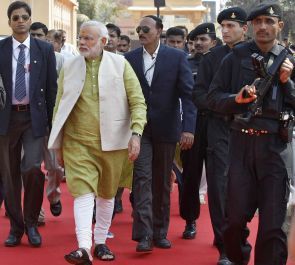 | « Back to article | Print this article |
 Prime Minister Narendra Modi is planning to track his bureaucrats through a centralised biometric attendance system linked to the Unique Identification Authority of India’s Aadhaar project.
Prime Minister Narendra Modi is planning to track his bureaucrats through a centralised biometric attendance system linked to the Unique Identification Authority of India’s Aadhaar project.
The new system will allow all government employees to mark their attendance from any central government department, by entering a six-digit unique number, besides finger prints or iris scan.
So, a defence ministry bureaucrat who has come to the finance ministry to see his boss, minister Arun Jaitley, can mark his attendance at an Aadhaar-linked machine installed at the entry of North Block.
The data on entry and exit timings of officers and other government staff, to be updated on a real-time basis, are likely to be monitored regularly by the Prime Minister’s Office.
“Many government departments already have separate biometric attendance systems but these are hardly used by senior officers.
People come late from meetings at other ministries or leave early for meetings elsewhere.
Now, such excuses won’t work. Data showing the location from where an employee marked his attendance will be available online,” said an official who did not wish to be named.
The attendance software is being developed with the UIDAI team’s assistance.
UIDAI is organising special camps at various government buildings to enrol employees who do not have Aadhaar numbers at present.
The department of information technology has written to all government departments to register the details of their employees on the portal, www.attendance.gov.in.
“They have asked us to get Aadhaar for marking attendance. So, one has to be in office on time, even as one rarely gets to leave on time,” said a senior government official, complaining.
The biometric system for attendance will be a hardware device, such as an Android tablet.
Desktop finger print devices will be installed in the offices of the rank of joint secretaries and above, besides section officers, to avoid rush at attendance terminals on entry gates.
According to government estimates, the machines at entry gates might be sufficient for 30 to 40 employees during the 30-minute peak load time.
Assuming 50 to 70 per cent employees come during the peak hours, one biometric terminal would be planned for catering to every 50 employees.
“The system will ensure anyone not coming to office but marking proxy attendance is held accountable,” another senior government official said.
The practice of marking attendance through proxies is more among lower-level employees like peons and clerks.
In fact, as a senior official from the agriculture ministry’s administrative wing said, there have been instances like a junior peon not attending office for five years but marking attendance all along.
The new system is expected to affect around five million government employees.
Though officials say it is a good move to begin with, not all are pleased.
“It is good that the government is introducing a system to check employees’ attendance.
"But coming early to work does not necessarily mean doing substantial work,” an official remarked.
Another rued that the new government was paying too much attention to these incremental administrative measures, taking away their flexibility, rather than focusing on big reforms.
According to the IT department, the system might initially take 30 seconds to one minute, depending on the number of attempts required.
With some practice and training, the time for marking biometric attendance could come down to less than 10 seconds per employee.
Since the Modi government took charge, some government employees say, the metro station at Central Secretariat, where many government offices are located, sees a huge rush around 9 am, as people scramble to reach office in time.
On one of these mornings, Information & Broadcasting Minister Prakash Javadekar made a surprise check and pulled up latecomers.
On another occasion, Urban Development & Housing Minister Venkaiah Naidu also appeared unannounced and directed all officials and ministry employees to be in their seats by 9 am.
It is not just officials who are finding it hard to adapt to long working hours without any “reward or appreciation”, the peons and other clerical staff are also struggling to get into the new mould.
A blog posted on his personal website, www.narendramodi.in, suggests Modi has been putting in 19 work hours a day since taking charge as prime minister.
“The same is the case with ministers. Take the case of the newly appointed Minister of State for Home Kiren Rijiju.
"The young minister himself admitted he had to adjust his sleep pattern keeping in mind the routine and work schedule of the prime minister.
Another Cabinet minister, Harsimrat Kaur Badal, recalled how she got a call from the PM at 9:00 am one day telling her she had to meet him in the next 10 minutes,” the blog added.
Image: Prime Minister Narendra Modi